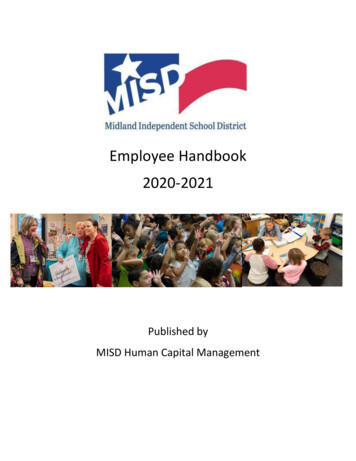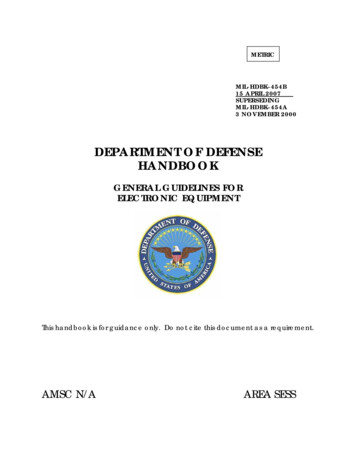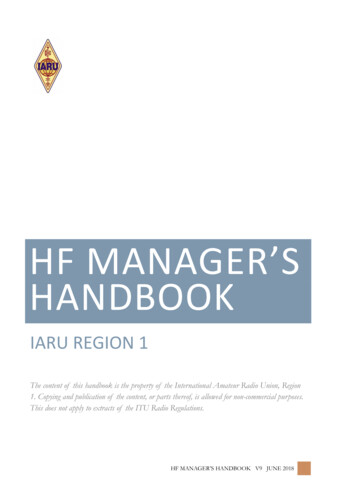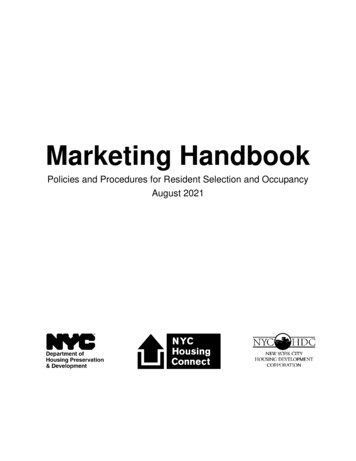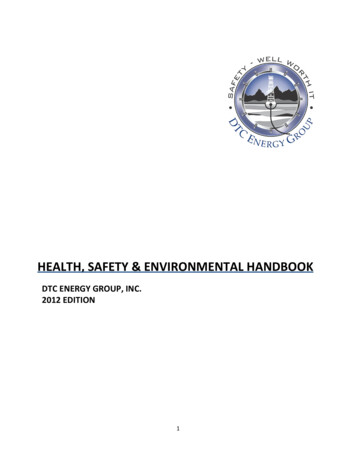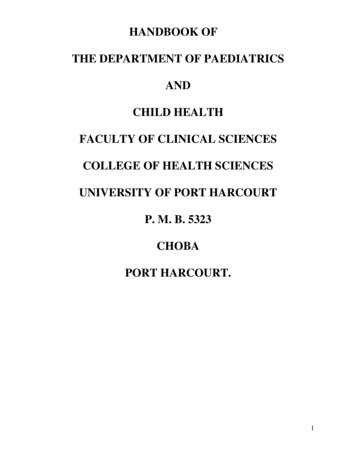
Transcription
HANDBOOK OFTHE DEPARTMENT OF PAEDIATRICSANDCHILD HEALTHFACULTY OF CLINICAL SCIENCESCOLLEGE OF HEALTH SCIENCESUNIVERSITY OF PORT HARCOURTP. M. B. 5323CHOBAPORT HARCOURT.1
TABLE OF CONTENTS1. Introduction .32. Principles of the Department .33. Objectives of the Course in Paedatrics Undergraduate Training .34. Training in Paediatrics .45. Training Curriculum .65. Students Assessment and Evaluation .11- Marking Scheme- Results6. Staffing of the Department .157. Teaching Aids and Recommended Textbooks .172
INTRODUCTIONThe Department is one of the clinical Departments in the College of HealthSciences.The department is accredited for undergraduate training by theNational University Commission (NUC) and the training of postgraduate doctorsby the West African College of Physicians (WACP) and the National PostgraduateMedical College of Nigeria (NPMCN).PRINCIPLES OF THE DEPARTMENTThe guiding principle of the department is to train medical practitioners who willbe able to provide care for children not only in this country but world-wide.OBJECTIVE OF THE COURSE IN PAEDIATRICS AND CHILD HEALTHThe students trained in this Department are expected, on qualification to:1. Have knowledge of the normal child and an understanding of the factors thataffect his growth, development and survival in our environment.2. Be in a position to organize comprehensive child care services in his area ofpractice3. Be able to organize programmes on health education and immunization inhis area of practice4. Be able to identify the at-risk group e.g. new-born babies and those under 5years of age5. Understand that due to limited finance, he should pay particular attention topriorities and cost benefit in planning and organizing child care services6. Be able to recognize the pattern and presentation of the common diseases ofinfancy and childhood7. Offer primary treatment for the common childhood diseases8. Make individual and community diagnosis of common childhood diseases9. Recognize serious and rare conditions which require specialist investigationsand treatment10. Judiciously use available modern diagnosis and therapeutic facilities.11. Be able to organize health care services in a rural area and functioneffectively as a leader of the health care for children12.Be able to recognize his limits during the care of a patient and refer the childfor further care13.Be interested in postgraduate work and furtherance of their course in thediscipline through update courses and research.3
TRAINING IN PAEDIATRICSThe academic programme of the department is carried out during the 9 months ofposting allotted to the Department of Obstetrics and Gynaecology and Paediatrics.In the first 2 months, each Department uses a month to deliver the didacticlectures. The next 6 months are divided into 2 periods of 3 months each. Duringeach period of 3 months, half of the students in the class will be posted to either ofthe department. At the end of the 3 months, the departments exchange theirstudents. The last month of the posting is spent for revisions and examinations.The training in the Department of Paediatrics is achieved through the followingactivities.A.Orientation Posting of One MonthThis period is spent to introduce the students to the department. The activitiescovered during this period include:iDidactic Lectures: The lectures on various aspects of paediatrics aredelivered by various lecturers from within and outside the Department. Thestudents are expected to sign an attendance which will be used to compute75% attendance for eligibility for exams.ii Bedside teaching: The students are taught on history taking and physicalexamination (general examination and examination of the 8 body systems).A test (essay and multiple choice questions) is given at the end of the lectures.The scores at this examination form part of the continuous assessmentscores.B.Main Posting of 6 monthsAt the start of the clinical posting, each student is expected to purchase the signingbooklet which will be used to capture attendance at all clinical exposure.1.Clinical Work and Teaching: The students are divided into 9 groupsand rotate through the various units supervised by different consultants.During this rotation each student is expected to:i. Participate in the day-to-day care of the patients, Clerking and follow-upof patients and participation in the procedures necessary for the care ofthe patient.ii. Attend ward rounds and clinic sessions during which they are expected toclerk, do clinical summary and present their patients to the supervisingconsultants and senior registrars.4
iii. Take Calls: This exposes them to the care of emergencies and thecontinued care for admitted patients outside the normal work period.iv. Within the posting evaluations (Unit test): Each team uses differentevaluation schemes for its students.These include clerking,examinations, tests and assignments. The scores obtained from theseevaluations form part of the scores allocated to continuous assessment.v. Attendance: each student is expected to have the signing booklet whichwill be signed daily by the unit consultant or senior Registrar. Attendanceat weekday and weekend calls should also be signed by the seniorRegistrar or Registrar on call. Observed procedures and those actuallyperformed are also signed in the signing booklet.2. Tutorials: This is done once a week on Mondays. The tutorial topics areformed from common ailments/diseases in children that need emphasis, or thosethat are easily missed and need to be discussed in a group setting. The students aregrouped into various tutorial groups different from unit grouping. Students areexpected to read/research on the particular topic for the week and make notesbefore the tutorial. During the tutorials, students participate in discussion on thetopics/cases selected for the day facilitated by the consultant and/or seniorRegistrar. All groups are expected to cover all the topics in the tutorial list. At theend of 3 tutorials, a post-tutorial test is carried out to evaluate learning. In all 4,tutorial tests are done and the scores from these tests form part of the continuousassessment.3. Departmental Teaching Programmes: Students are expected to fully participatein the various teaching programmes in the department. These include:i. Postgraduate Seminars, Case Presentations or Case Analysis which holdsevery Thursday from 1:30 – 2:30 pm.ii. Mortality and Perinatal Mortality Meetings - The mortality meeting isheld every Wednesday from 9.00am – 10:00am to review patients thatdied in the preceding week, while the perinatal mortality is held withObstetrics and Gynaecology department on the last Friday of each month.iii. Radiology Seminars – Joint meeting with the Radiology Department toreview radiographs –holds every Tuesday from 1-2 pm.iv. Post Mortem examination –holds whenever there are cases. It is a jointmeeting with the Morbid Anatomy Department.v. Seminars/Workshop on various subject of relevance to child health.4.Visitation to places where children in various circumstances are caredfor: These include:i. Infant Welfare Clinics to learn the care for healthy childrenii. Special School for handicapped children5
iii. Home for children in difficult circumstances-The Port HarcourtChildren’s Home (for abandoned or motherless babies), The RemandHome for children undergoing institutionalized corrections and theHome for Handicapped Children.C.5.McArthur Clinical Skills Laboratory: where the student watch videomodules of system exam. Students are also encouraged to presentthemselves for video capture to evaluate their proficiency at physicalexamination6.Social Visits to the homes of children being cared for in the hospital toascertain social circumstances including their home environment and toappreciate how these affect the health of the children.7.End of Posting Test. At the end of the three months of rotation, an end ofposting test comprising written and clinical examinations is carried forthe students. The scores obtained from this also form part of the scoresallocated for continuous assessment.Revision and final examinationsAt the end of the rotations through the Departments of Paediatrics and ChildHealth and Obstetrics and Gynaecology, a two week revision is carried outfollowed by the final examination which comprises written (essays and multiplechoice questions), a clinical examination (Performance and Cognitive SkillsEvaluation {PACSE}; Objective Structured Pictorial Evaluation {OSPE}; ClinicalReasoning) and an oral examination. The scores from these aspects of theexamination are scaled down to 70% of the total scores in the final examination.TRAINING CURRICULUMThe student is expected to cover the following areas in Paediatrics. Lectures shallbe given to cover these subjects.1. THE NORMAL CHILDi. The new-born: Examination and care of the new-bornii. Growth and development:norms and parameters of growth anddevelopment-weight, height, head circumference and skin fold thicknessiii. Principles of development (physical, social, emotional and intellectual)iv. Method of development assessment:6
- Early detection of handicaps- Use of anthropometry to assess growth2. THE SICK CHILDi. History Taking, examination and diagnosis in Paediatricsii. Prenatal Diagnosis-the effects of various maternal and environment factorson the foetusiii. Neonatal Problems:- Birth Asphyxia- Congenital abnormalities and malformation- Neonatal Infections- Birth Trauma-cephalhaematoma, bone injuries, cerebral trauma, nerveinjuries.- Biochemical – hyperbilirubinaemia, hypogylycaemia, hypocalcaemia,hypomagnesaemia- Haematological diseases in the newborn- Prematurity and Low birth weightiv. Malnutrition- Protein-energy malnutrition-classification, diagnosis and management.Sequelae of malnutrition.- Diagnosis of malnutrition in the community and the assessment of thenutrition in the community (anthropometric and biochemical)- Vitamin deficiencies in infancy and childhood- Interactions between malnutrition, measles, tuberculosis and pertussisv. Common Childhood Infections:- Protozoal-Malaria, Giardiasis and Amoebiasis- Fungal-Monilia and Cryptococcus- oidiasis,Paragonimiasis, Taeniasis and Filariasis- Bacterial- C. Tetani, H. influenza, Meningococcus, pertussis,tuberculosis, S. aureus, streptocoous, E. coli, Klebsiella- Viral-Measles, Herpes simplex variola and varicella, mumps, rubella,poliomyelitis adenovirus, coxsackie virus, Echo virus, rabies and theHuman Immunodeficiency Virus.vi. Cardiovascular System:- Anatomy and Physiology (including the embryology of the heart)7
- Congenital heart diseases: Ventricular Septal Defect, Fallot’s Tetralogy,Atrial Septal Defect and others- Acquired heart diseases especially Rheumatic Heart Diseases- Endomyocardial Fibrosis and other cardiomyopathies- Principles of investigations, diagnosis and treatment of heart diseases- Cardiac Failure in childhood and its management- Examination of the Cardiovascular Systemvii.-Respiratory SystemWheezing Child and AsthmaTuberculosis – Pulmonary and extrapulmonaryAetiology, clinical presentation and management of common respirationemergencies – epiglotitis, croup, bronchopneumonia, lobar pneumonia,bronchiolitis, acute respiratory tract obstruction etc.- Pleural effusion- Examination of the Respiratory Systemviii.-Digestive SystemThe child with abdominal painDiarrhoeal diseases and their managementVomiting in childhoodAcute Intestinal ObstructionPancreatitisMalabsorption SyndromesHepatosplenomegalyExamination of the Digestive Systemix. Endocrine Disorders- Obesity- Pituitary gland-physiolgy and functions, Diabetes Insipidus, GrowthHormone deficiency, Short stature- Adrenal gland-physiology and functions, Congenital adrenal hyperplasia,Neuroblastoma, Phaechromocytoma, Addison’s Disease- Pancreas-Diabetes Mellitus- Gonads-Turner’s Syndrome, Klinefelter’s Syndrome, Intersex states,Ambiguous genitalia, precocious/delayed puberty.- Thyroid gland – Hypothyroidism, Hyperthyroidism, Iodine deficiencydisorders- Parathyroid gland-Vitamin D metabolism, calcitonin- Examination of the Endocrine System8
x. Disorders of the Nervous System- Convulsions in childhood- Infections-meningitis, poliomyelitis, encephalitis, tetanus- Hydrocephalus, microcephalus- Cerebral palsy and the handicapped child- Intracranial tumours in childhood- Peripheral nerve and muscles disorders-progressive muscular dystrophy,pyomyositis, spinal muscular dystrophy- Principles of investigations of CNS disorders- Psychiatric disorders in children- Examination of the Nervous Systemxi. The Urogenital System- Anatomy and physiology of the Kidneys- Development and Structural anomaly of the genitourinary tract- Investigations of the urinary tract- Renal function tests- Urinary Tract Infections- Glomerulonephritis- Nephrotic Syndrome- Renal Failure – acute and chronic- Renal Replacement Therapy- Wilm’s Tumour- Haematuria in childhood- Examination of the Urogenital Systemxii. Haemopoietic and Lymphoreticular System- Common causes of anaemia in the tropics (neonate, infancy and the olderchild)- Haemoglobinpathies especially HbSS disease- Port wine stains and Haemangiomas- Malignant diseases-Leukaemia, Hodgkin’s Disease and Burkitt’sLymphoma- Bleeding disorders – Haemophylia, Haemorrhagic disease, Disseminatedintravascular coagulopathy, Purpura- Examination of the Haematologic Systemxiii.-Social PaediatricsPattern of childhood diseases in NigeriaChildren in especially difficult circumstancesChild abuse – sexual, physical, emotional9
- Adolescent problems- Population structure in development countries- Organization of child health services in the community, school healthservices, infant welfare clinics and under-fives clinics- Motherless babies, accidents in the home, non-accidental injury- Illegitimate babies, adoption, foster parents, handicapped children.- Vital statistics in relation to children- Population growth and economic factors as restraints in health caredelivery- Palliative Carexiv.-Common Skin DisorderSkin lesions – macules, papule, pustule, nodules, patchesEczemaCongenital/hereditary skin disorders e.g. naevus,Infections-impetigo, scabies, molluscum contagiosum, Tinea, moniliasis,warts- Allergic skin conditions-urticaria etc.xv.Primary Health Care and Community Paediatrics- Primary Health Care and Child survival strategies- Out Patient Management of Acute Respiratory Infections using the WHOGuidelines- Childhood Immunizations and missed opportunity- Integrated management of childhood illnesses.xvi. Others- Communication and Patient Education- Ethical issues in Paediatrics- Principles and applications of Preventive Paediatrics- Genetic disorders – single mutant gene -autosomal (dominant/recessive)and sex chromosomes (dominant/recessive), chromosomal abnormality(Down Syndrome, Edward Syndrome, Patau Syndrome)TUTORIAL TOPICSThe following topics are covered during the tutorial sessions.1. Malaria2. Anaemia in Children3. Sickle Cell Disease4. Protein Energy Malnutrition5. The wheezing Child10
6. Pneumonias-aetiology, pathology, signs7. The Unconscious Child8. Renal Failure – Acute and chronic9. Acute Glomerulonephritis10. Nephrotic Syndrome11. Urinary Tract Infection12. Neonatal Jaundice13. Congenital Heart Disease (TOF &VSD)14. Cardiac Failure15. Leukaemia/Lymphoma16. Birth Asphyxia17. Newborn Resuscitation18. Childhood HIV InfectionSTUDENTS ASSESSMENT AND EVALUATIONThe students are assessed during their posting in the various areas; lectureattendance, clinical rotations, tutorial and the end of posting examinations. For astudent to be qualified for Part III MBBS examinations, he/she is expected toachieve a minimum attendance requirement of 75%. Failure to achieve thismandatory 75% attendance in Paediatrics will disqualify the student from writingthe main / resit examination that year, in Paediatrics and Obstetrics andGynaecology and vice versa. The student will be required to repeat the entireposting.1. Continuous assessment scores: These form 30% of the total final scores. Itis computed using the scores obtained at the orientation test, unit tests, posttutorial tests and end of posting tests. The table below gives a summary ofthe continuous assessment format in Paediatrics.Continuous assessment formatABCOrientation tests1 ESSAY2 MCQPost-tutorial testsUnit tests (during each posting rotation)1 Clerking and presentation of caseScaled Scores10010025011
DEF2 Clinical Reasoning Summary3 Other group assignments4 End of unit rotation testEnd of posting tests1 MCQ2 Essay / Short question3 Clinical – PACSE, Clinical Reasoning, OSPE, OralsTotal Collated scoresScaled toAdditional make up test for resitTotal collated scoresScaled to30075030%10085030% (new CA)2. Final Part III MBBS examination scores: The scores obtained at the finalexamination contribute 70% of the total scores allotted in the department ofPaediarics. The Part III MBBS examination in the department comprises differentsections.a. Written examination: This consists of: (i) 100 multiple choice questions(“True or False”). The first 20 questions explore the student’s ability to review the8 body systems. The remaining 80 questions cover all the topics in paediatrics.(ii) Five Essay questions which a student is expected to answer all.b. Clinical Examination:i. Clinical Reasoning (Structured Multiple Choice Questions)ii. Objective Structured Pictorial Evaluation (OSPE)iii. Viva Voce (oral examinations):The oral examination is a short discussion ofSocial Paediatrics as well as general and topical issues in Paediatrics.iv. Performance and Cognition Skills Evaluation (PACSE). Below are the differentPACSE blue prints used:12
PACSE BLUEPRINTSTATION 115 MINUTESCandidate 1History of Presenting Complaints-5 minutesTreatment or Past Medical or Familyand Social History-5 minutesReview of Systems-5 minutesCandidate 5Candidate 2STATION 5 15 MINUTESTreatment and or MonitoringOrder-10 minutesProcedure[Therapeutic/ Investigative]or Preventive /Anticipatory Management-5 minutesSTATION 215 MINUTESDigestive & GenitoUrinary SystemsExamination-10 minutesEndocrine, Respiratory or MusculoSkeletal System Examination -5 minutesCandidate 3Candidate 4STATION 415 MINUTESSTATION 315 MINUTESCommunication skills –Counseling-10 minutesCentral Nervous SystemExamination-10 minutesCommunication skills –Ethics orHaematologic or CardiovascularSystem Examination-5 minutesInformed Consent-5 minutes12PACSE EXAMINATION BLUE PRINT 90MINUTES TABLE AStationPerformance/Cognition ActivityMinsRoles – Candidates/ExaminersStation 1History of Presenting Complaints5Read instruction and write/ReadScript and ScoreTreatment History5Read instruction and write/ReadScript and ScoreReview of Systems5Read instruction and write/ReadScript and ScoreStation 2Digestive and Genitourinary System10Read instruction &Examinationperform/Observe and ScoreRespiratory System Examination5Read instruction &perform/Observe and ScoreStation 3Central Nervous System Exam10Read instruction &perform/Observe and ScoreHaematologic System Exam5Read instruction &perform/Observe and ScoreStation 4Communication Skills – Counselling10Read instruction &perform/Listen and ScoreCommunication Skills - Ethics5Read instruction &perform/Listen and ScoreStation 5Treatment and/or Monitoring order1Read instruction and write/Read0Script and ScoreProcedure: Investigative or TherapeuticRead instruction and write/Read5Script and ScoreIntervals3 mins interval between 5 Stations1Fill name and sign sheets/Enter5ScoresTotal90PACSE EXAMINATION BLUE PRINT 90MINUTES TABLE BStationPerformance/Cognition ActivityMinsRoles – Candidates/ExaminersStation 1History of Presenting Complaints5Read instruction and write/Read Scriptand ScoreFamily & Social History5Read instruction and write/Read Scriptand ScoreScores44484848484060Scores4413
Station 2Station 3Station 4Station 5IntervalsTotalReview of Systems5Digestive and Genitourinary SystemExaminationEndocrine System Examination10Central Nervous System Exam10Cardiovascular System Exam5Communication Skills – CounsellingCommunication Skills – InformedConsent10Treatment and/or Monitoring orderPreventive/AnticipatoryManagement103 mins interval between 5Stations15555Read instruction and write/Read Scriptand ScoreRead instruction & perform/Observeand ScoreRead instruction & perform/Observeand ScoreRead instruction & perform/Observeand ScoreRead instruction & perform/Observeand ScoreRead instruction & perform/Listen andScoreRead instruction & perform/Listen andScoreRead instruction and write/Read Scriptand ScoreRead instruction and write/Read Scriptand ScoreFill name and sign sheets/Enter Scores90PACSE EXAMINATION BLUE PRINT 90MINUTES TABLE CStationPerformance/Cognition ActivityMin Roles – Candidates/ExaminerssStation 1History of Presenting Complaints5Read instruction and write/Read Scriptand ScorePast Medical History5Read instruction and write/Read Scriptand ScoreReview of Systems5Read instruction and write/Read Scriptand ScoreStation 2Digestive and Genitourinary System10Read instruction & perform/Observe andExaminationScoreMusculoskeletal System Examination5Read instruction & perform/Observe andScoreStation 3Central Nervous System Exam10Read instruction & perform/Observe andCardiovascular System ExamScore5Read instruction & perform/Observe andScoreStation 4Communication Skills – Counselling10Read instruction & perform/Listen andCommunication Skills - EthicsScore5Read instruction & perform/Listen andScoreStation5Treatment and/or Monitoring order10Read instruction and write/Read ScriptProcedure: Investigative or Therapeuticand Score5Read instruction and write/Read Scriptand ScoreIntervals3 mins interval between 5 Stations15Fill name and sign sheets/Enter ng schemea. The multiple choice questions- usually 100 in number, have a main stem eachand 5 options to which a candidate answers true or false. Each correct answerscores a point, a wrong answer leads to the loss of one mark and failure to answer aquestion attracts no score. The total score 500 is scaled down to the mark allocated14
for MCQ in that part of the examination i.e 50 mark at the orientation and end ofposting tests and 80 marks at the final examinations.b. Essay question – There are usually 5 essay questions. All essay question carryequal marks and students are expected to answer all. At the continuous assessmenttests, an open marking scheme, where a minimum of 0 and a maximum of 20marks can be scored for each of the 5 questions, is used. At the final examination,in line with the college’s marking scheme, a closed system of marking is used –with minimum scores of 6 and maximum of 14 indicative of very poorperformance (6), average performance – pass (10) and excellent performance(14).The 100 marks obtained is scaled to 25 at the orientation test, 50 at the end ofposting test and 100 at the final examination.FINAL RESULTThe final score is the sum of the main examination scores scaled down to 70% andthe continuous assessment accounting for 30%.To obtain a pass the candidate mustScore 50% or above in the clinical examinationand 50% or above in the overall score.A candidate who passed the clinical examination and fails in the overall score ORfailure in both sections of the examination is said to have failed (F)A failure in the clinical examination and a pass in overall is said to fail clinical(FC)THE RESIST EXAMINATIONThe resist examination is held at least 12 weeks after the main examinationfollowing the same pattern as described above. Students are encouraged toparticipate in the various teaching sessions with the consultants and departmentalactivities to improve their learning during this period. A make up test is organizedwhich is added to their initial scores and used to recalculate the continuousassessment scores. The conduct and marking of the examination is same as in themain examination.THE ACADEMIC STAFF IN THE DEPARTMENT:The Department has 21 full time lecturers, there are 7 (seven) Professors, 2(two) Readers, 10 (ten) Senior Lecturers and 2 (two) Lecturer I. With 160students, the full time staff: student ratio is 1:8 during the clinical postings. Thenames and qualifications of the full time staff are as follows:15
S/N NAME1Prof. F. Eke2Prof. K. E. O.Nkanginieme3Prof. A. R. NteQUALIFICATION RANKFRCH,FWACP,FMC ProfessorFMCPaed, FWACPProfessorFWACPProfessor4Prof. I. C.AnochieProf. A. U.EnehProf. N. A.AkaniDr. E. A. D.AlikorDr. Angela I.Frank-BriggsDr. R. Neonatology/InfectiousDiseaseOncology/Social Pead.FWACPProfessorNeurology/ RespiratoryFMCPaedReaderNeurology/ RespiratoryFWACPReaderFWACP11Dr. B. E.OtaigbeDr. I. George12Dr. G. EkeFWACP13Dr. P. OparaFWACP14Dr. P. TabansiFWACP/FMCPaed15FMCPaed17Dr. L. YaguoIdeDr. B. AlexHartDr. T. Jaja18Dr. N. PaulFWACP19Dr. BomaOkohDr. I. YarhereDr. J. rerSnr.LecturerSnr.LecturerSnr.LecturerLecturer ILecturer logyMedical csNephrologyHaematologyOncology/ NutritionNeonatologyCardiologyCommunity /Preventive PaediatricsCommunity PaediatricsEndocrinologyInfectious DiseaseNeurology/ RespiratoryEndocrinologyNeonatology16
Teachings are also carried out by the staff of the department in the Teaching Hospital whichcomprises 25 senior registrars, 14 registrars and variable numbers of house officers and nurseof all grades. Part time lecturers comprising of Lecturers in Orthopaedic Surgery, PaediatricSurgery, Psychiatry and Radiology are also involved in lecturing the students.The Department also has non-teaching staff comprising one administrative officer, oneSecretary, one clerical officer, one caretaker and a cleaner.MentorshipAt the start of the programme, each student is assigned a mentor who follows up theacademic performance and character molding of the student. The mentor tries to identify anyproblem that may affect the academic performance of the mentee and offersintervention/advice.Teaching Aids In The DepartmentThe Department has the following equipment for teachings: One Television Set Projector and screen for presentations Sharp Photocopying Machine DVD Cassettes for Teaching LCD multiplier pole protector and screen in the year 5 class and public addresssystem for student lectures. Photographs of various diseases conditions Side Laboratory with Microscope, Microhaematocrit Centrifuge and Reader Reagents for various tests and Slides X-ray viewing boxes in each of the wards and the clinics for TeachingRecommended Textbooks1. Paediatrics and Child Health in the Tropics2. Diseases of Children in the Tropics by Jolly3. Nelsons Textbook of Paediatrics4. Diarrhoea Training Manual5. Textbook of Clinical symptoms, Signs and laboratory parameters17
HANDBOOK OF THE DEPARTMENT OF PAEDIATRICS AND CHILD HEALTH FACULTY OF CLINICAL SCIENCES COLLEGE OF HEALTH SCIENCES UNIVERSITY OF PORT HARCOURT P. M. B. 5323 CHOBA . At the end of the rotations through the Departments of Paediatrics and Child Health and Obstetric





